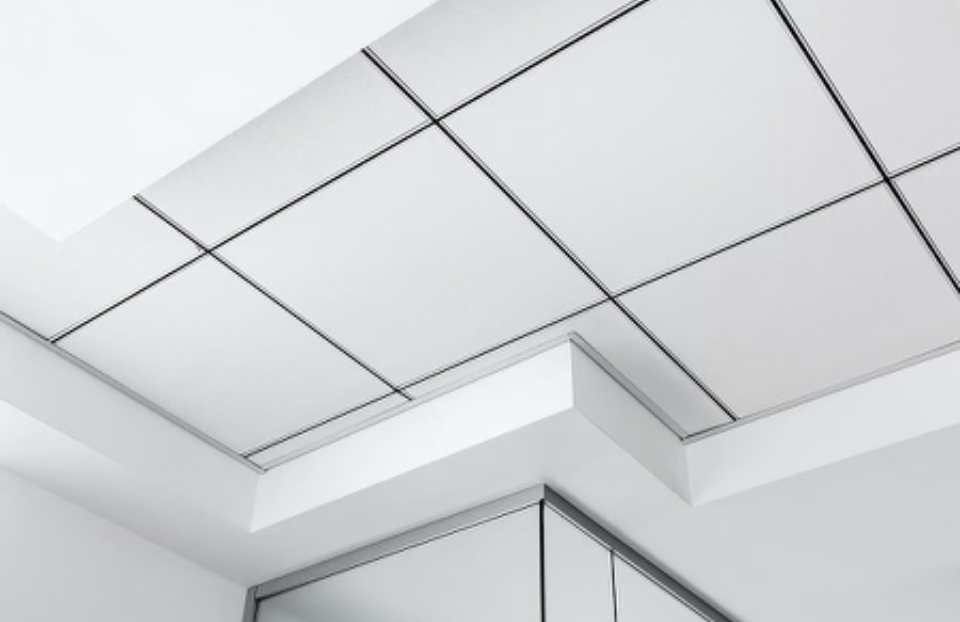Acoustical Ceilings
What are Acoustical Ceilings, and how do they work?
Most of us have heard about soundproofing walls, but did you realize you can also soundproof your ceiling?
Acoustical ceiling tiles are classified into three types: those that absorb, those that block, and those that disperse sound. Celiume does an excellent job of clarifying the technical words for these three types of ceiling tiles, which are classified and known in the industry as:
Noise Reduction Coefficient (NRC)
The Noise Reduction Coefficient (NRC) is a broad metric that indicates how much sound a surface (in this example, a ceiling tile) can absorb. This rating is given as a percentage or a decimal, with 1 (or 100%) representing perfect absorption and 0 (or 0%) representing perfect reflection. In other words, the larger the decimal or percentage, the greater the sound absorption of the tile. While this gives a decent sense of how a tile will behave acoustically, it does not tell you what happens to the sound that is not absorbed by the ceiling tile.

Sound Transmission Class (STC)
The Sound Transmission Class (STC) rating system is used to assess the capacity of various construction materials to block sound and prevent it from flowing through them. This is widely used on walls and partitions since it aids in determining which sorts of partitions will adequately separate different portions of a structure. STC ratings are represented by a number, often between 1 and 100, although not always.
The greater the number, the better the material in sound absorption. A rating of 10 is regarded as poor, as it allows talking voices to be heard through the rated system, but a rating of 60 or more is considered good.
Sound Transmission Class (STC)
The Sound Transmission Class (STC) rating system is used to assess the capacity of various construction materials to block sound and prevent it from flowing through them. This is widely used on walls and partitions since it aids in determining which sorts of partitions will adequately separate different portions of a structure. STC ratings are represented by a number, often between 1 and 100, although not always.
The greater the number, the better the material in sound absorption. A rating of 10 is regarded as poor, as it allows talking voices to be heard through the rated system, but a rating of 60 or more is considered good.
Ceiling Attenuation Class (CAC)
The Ceiling Attenuation Class (CAC) is a whole different grading system. It is more precise in its approach to sound absorption and attenuation.
Sound can travel up into the ceiling plenum, over the wall, and then back down into another room in an installation with a drop ceiling and walls that only extend up to the drop ceiling level. The CAC is the rate at which ceiling tiles prevent sound from passing through. This grade is sometimes misinterpreted as describing how much sound bounces off the face of a tile.
This is a common fallacy, and the CAC rating should not be used to describe any circumstance other than the ones listed above.
Sound-absorbing ceiling tiles are the most popular of the three primary groups since they help to reduce sound reverberation within a space. These tiles aid in reducing echo and improving sound quality. Furthermore, if you live in a multi-story structure, acoustic ceiling tiles may be quite useful in filtering sound from other floors.
FAQs Related to Acoustical Ceilings
What is an acoustical ceiling?
Acoustic ceiling panels act as sound barriers, preventing sound from flowing to neighboring rooms and reducing noise within a space. Acoustic panels contribute to the creation of a more comfortable atmosphere by softening, removing, and diffusing noises.
What is acoustic ceiling material?
These are the most frequent tiles used in commercial suspended ceiling applications, and they are often created from a combination of waste paper, mineral fiber (which may contain slag, a waste product from steel production), corn flour, and various other mineral-based components.
Where is the acoustic ceiling used?
Acoustic panels may be used efficiently in a variety of settings, including restaurants, pubs, workplaces, and music venues. As you might expect, each location has its own set of needs, but they all stem from the desire to increase sound quality and intelligibility. You can contact MB Construction to learn how else we recommend using them!
What are the two types of acoustic panels?
Many types of acoustic panels are available, including art, fabric-wrapped, and perforated acoustic.
